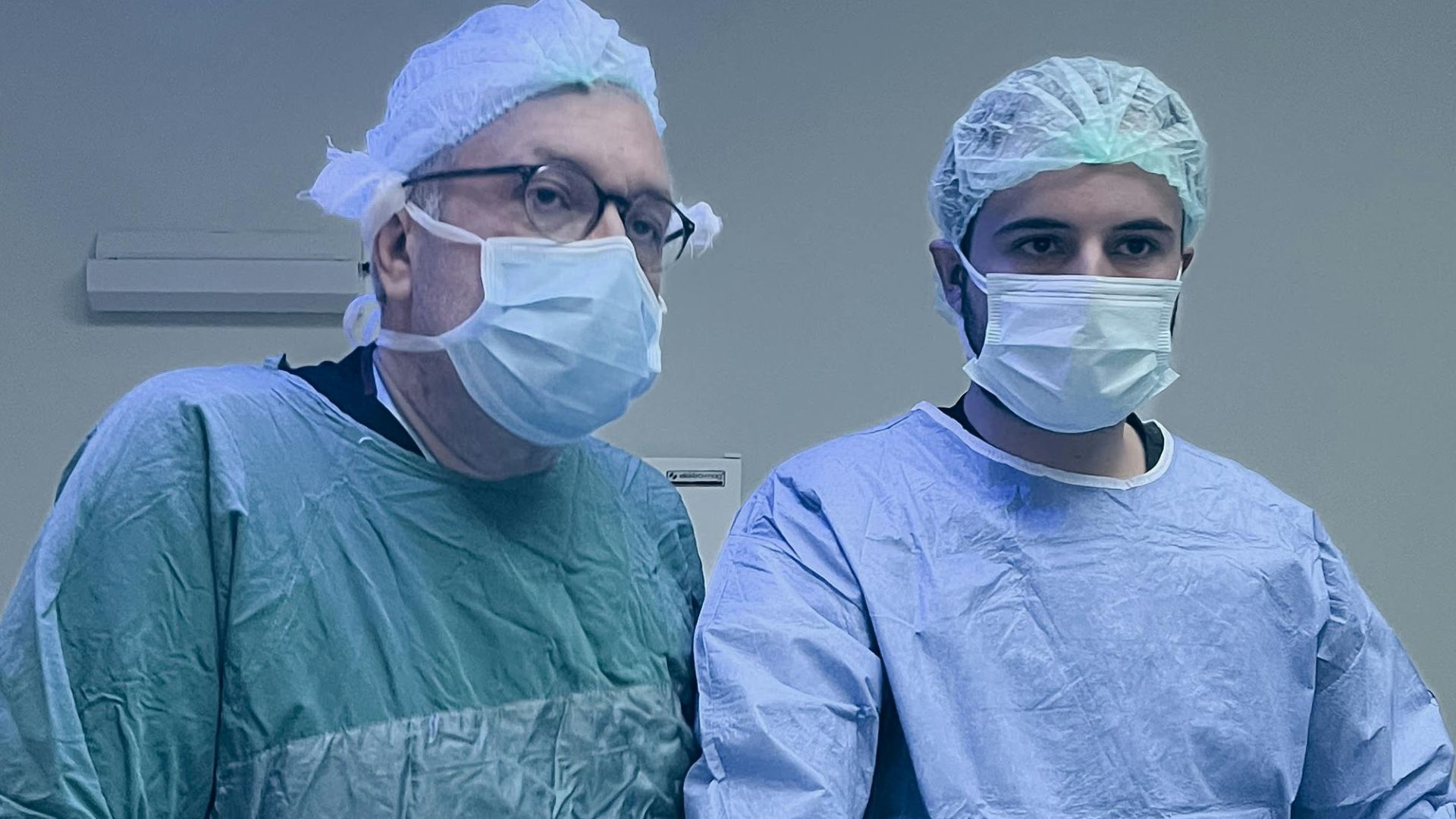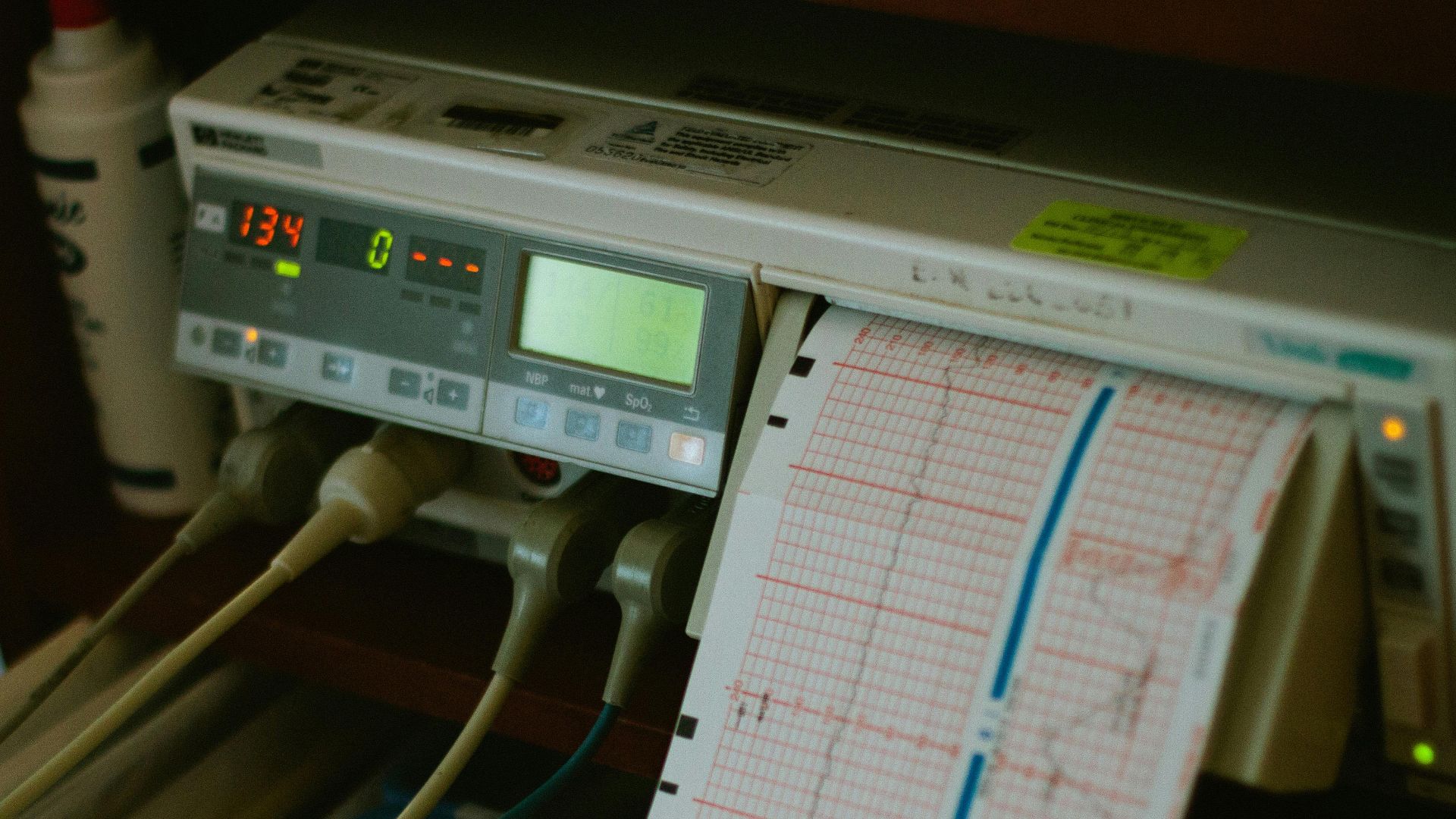Medical dramas are full of thrilling cases that are so wild that only a writer could have come up with them. But believe it or not, there are just as many wild, heartrending, and miraculous medical stories in real life! Doubt us? In these stories, a group of doctors, nurses, patients, and veterinarians prove that some hospitals don't need script-writers and actors to be as melodramatic as Grey’s Anatomy.
1. Talk To Me
I was a speech-language pathologist when I saw a person who had fallen 30 feet through a disused factory roof. They had skull fractures, multiple strokes, multiple organ trauma, multiple spinal fractures, and had a tracheotomy. I was there to assess speech and review eating and drinking. Reading their notes I imagined that there would be serious issues...to say the least.
They were able to eat and drink with only slight modifications. They could speak using a speaking valve and had no problems with understanding or finding words or unclear speech. They seemed slightly amused and bored by my assessment. They even took my notebook and pen and wrote “I can write too” in flawless handwriting.
I finished placement not long afterward, but they were expected to make a full recovery!
2. Gut Feeling
My husband is a doctor. One night, he came home with a surreal look on his face. He had been seeing a patient and noticed that although he was in his mid-20s, he didn't seem to have gone through puberty. The patient didn't mind his state too much but my husband believes that medicine should improve your life, not just keep it going.
So, on a shot-in-the-dark hunch, my husband sent him for an MRI. The patient had a previously benign and now malignant brain tumor suppressing the part of the brain that controls puberty. The test led to a very early brain tumor detection.
3. A Relief
I had a patient who was recently pregnant and was experiencing some minor bleeding. I did an ultrasound and saw a normal fetus but no heartbeat. I told her that it was likely due to pregnancy just being at an early stage. I checked her ovaries and told her that I could print a picture of the fetus. I moved the scan back to the fetus and there was a clear heartbeat.
During the minute or so that I was scanning the ovaries, the heart had started to beat.
4. Right Place, Right Time
I'm a nurse, and this happened in the car park of the hospital where I work. A staff member got out of his car only for it to start rolling back. He reached in to pull the hand-brake. From where I was sitting, everything looked fine, but a few minutes later a lady walked by and starts screaming. Turns out he had been pinned half inside his car. He was unconscious and he wasn't breathing.
A bunch of us managed to push his car back enough for people to pull him out. Luckily all this happened at a hospital so the crash team had already been called. They did CPR. He lived.
5. Free at Last
I have a somewhat rare condition called hemicrania continua which means I have a migraine headache on one side all the time. I have a stimulator implanted to interrupt the signals. It was an amazing thing to have it turned on after surgery and finally be headache free. I was lucky to live near the syndrome's most respected doctor.
We walked in and he knew what was going on at once—but it still took five years to get approved for the implant.
6. Nothing Like It
My mother was a GP in the middle of nowhere in southwest France. In the early 90s, she encountered her first case of HIV. With the medicine available at the time, they did not last long. Except one. He clearly had HIV but he never developed AIDS. He was one of the few, incredibly lucky people who are naturally immune.
7. Tangled Up
During my residency, I worked in a unit that did a lot of urology. We had a series of regular patients with urethral strictures (narrowing of the urinary passage) and they used to visit from time to time to get their strictures dilated. These veterans would eventually learn how to catheterize themselves. One of the patients, a young boy of 14 whose original injury had been a pelvic fracture in a road traffic accident, came to the ER on a Saturday in considerable discomfort.
I was on call and asked him what happened. He said, "I passed this catheter in and I can't get it out." I quickly figured out why: he wasn't using wasn't really a conventional urinary catheter. He was using an infant feeding tube because the conventional catheters were too big for his narrow passage. Unfortunately, I couldn't get the catheter out either.
The catheter was fitting so snugly in the stricture that he couldn't pass urine and his bladder had filled up like a balloon about to burst. We took him to the OR and did a suprapubic cystostomy (basically made an opening into the bladder from the abdomen). This relieved the pressure in the bladder. Next, we passed a scope down the SPC and found that the feeding tube that he had used as a catheter had gone into the bladder and got knotted around itself.
Every time we tugged on it, the knot was getting tighter. We had to cut it off below the knot to get the rest of the catheter out. It was a stressful day for everyone involved.
8. No Relation
There was this Italian family with inherited fatal familial insomnia (FFI). This is a horrible disease that destroys the part of your brain that allows you to sleep. You die after six or eight terrible months (during which you cannot sleep, have panic attacks, rapid-onset dementia, and occupy a permanent limbo between waking and sleeping).
9. Thick
I saw a patient whose triglycerides were so high that they gave him pancreatitis. That's already rare, but the really crazy thing was that when we drew blood, it actually separated. You could see a layer of fat in the vial.
10. Knuckle Cracking
At 3 AM on a Saturday, I was working in the emergency room of a trauma center. We heard that we were getting three people from a shoot-out—but nothing could prepare us for the carnage. The first person wheeled in...just didn't seem to have a head. There was this bloody mass at the top of his neck but it didn't look human.
I remember being so confused that we were using one of the bays for this person/body, who just could not still be alive. I was looking him over and I noticed his left thumb was calmly and repeatedly cracking the knuckles on his left hand. It would squeeze one finger and rhythmically work down the other four and start over.
He didn't have any anatomy left that we could easily intubate and yet he was cracking his knuckles. I still can't make sense of it. He didn't stay alive much longer, maybe a couple of hours, but that knuckle cracking seemed like such a human thing to do for someone that had no reason to still be alive.
11. Taking Up Space
When I was an intern in the Emergency Room, a 30-something-year-old guy came in with simple URTI symptoms, essentially coughs and the flu. However, the paramedics at triage found that the oxygen concentration in his blood was low and that there were some crepitations in his left lung. Pretty standard, early-stage pneumonia.
I didn't like the sound of his crepitations, however. It was way too loud, but the patient was very comfortable so we sent him off to get some x-rays. I got my answer and the shock of my life when he came back. His left chest cavity was filled with bowels. The crepitations that I heard were bowel sounds.
The guy had no left lung, and his intestines had moved into the empty area. Judging from his comfort level and his own shock, we suspected it was congenital. We diagnosed him with a simple upper respiratory tract infection and sent him home after routine observation.
 Krakenimages.com, Shutterstock
Krakenimages.com, Shutterstock
12. Baby Powerball
A co-worker's son was born with hypoxic-ischaemic encephalopathy. Basically, the valve controlling blood flow to and from his mother while in utero failed, and he was born with 30% of the blood volume you're supposed to have. The EEG came back showing massive anomalies—little dude wasn't quite at the threshold of brain-death, but my co-worker and his wife were told in no uncertain terms that he would never live off a ventilator, and it was pretty unlikely he'd ever open his eyes.
The hospital persisted with treatment, though, and brought in a trauma team who worked on him for nearly a week, before three more weeks in the NICU trying to control the seizures and prop up his organ function. Fast forward to yesterday, when the little dude made an appearance at a house party we threw. He's almost two and is neuro-typical.
He walked up our treacherous back staircase by himself and was talking up a storm in a language no one knows. He was a big fan of our cat. His entire trauma team came to his first birthday party, because none of them would believe it without seeing it. His entire brain basically regenerated and rewired itself after he was on the verge of brain death.
It's the most unbelievable thing I've ever seen. Guy basically won the Powerball a couple of times in the first two weeks of his life.
13. Ups and Downs
In the ER, we give an antibiotic called Rocephin to patients with UTIs. The only complication I’ve ever seen from it is vomiting if it’s pushed too fast. I had a patient transferred from our urgent care side who had walked in fairly healthy, but was complaining of UTI symptoms. They had tested his urine, diagnosed him with a UTI, given him Rocephin, and were planning on discharging him with oral antibiotics.
We still don’t know completely what happened, but this is our best guess. We think he had a gram-negative infection that reacted to the Rocephin by “lysing.” The bacteria essentially exploded and raced through his body, putting him into almost instant septic shock. He had to be intubated and put on blood pressure medications to keep his BP high enough to perfuse his organs.
His temperature skyrocketed A central line was placed because we kept running out of IVs to give medications. He was transferred to an ICU. I have never before visited a patient of mine in the ICU but because of his drastic decline, I had to see him and know how he was doing. I cleared it with the ICU charge and visited him two days later.
He was extubated and walking almost on his own. One of the fastest declines and recoveries I’ve ever seen.
 Krakenimages.com, Shutterstock
Krakenimages.com, Shutterstock
14. Missing Tooth
As a dentist, I'm used to seeing unerupted teeth still stuck in the bone, especially the third molars and canines. (We confirm tell which are unerupted by looking at x-rays). I was seeing this radiograph of a colleague's patient who had a missing canine. We were expecting to find it stuck in the bone but... we couldn't.
We thought maybe it was missing until we realized that it was impacted in a very strange place. It was just below the patient's eye, lying horizontally.
15. Fixing a Broken Heart
I saw a teenager have a heart attack. This jacked, athletic kid with eight-pack abs fell on the ground and started clutching his chest during basketball practice. Everyone in the pediatric ER thought it was a panic attack except for the adult ER resident who said: “I’ve seen hundreds of heart attacks. He’s having a heart attack. Don’t ask me why, but that’s what this looks like.”
And that’s what it was.
He had an inborn anomaly where one of the coronary arteries coursed between the pulmonary artery and the aorta. During exercise, the aorta and pulmonary artery expand with the increased cardiac output and for whatever reason, that was the day that they squeezed a right coronary artery and caused a massive myocardial infarction.
It was bad news bears. The damage was so bad, the kid needed a heart transplant. He was transferred to a pediatric heart center. A left ventricular assist device (LVAD) was implanted because his heart function was so poor. A donor heart was found and as he was being prepared for surgery, his own heart decided to suddenly start working again. It turns out that hearts can heal after a massive heart attack (especially teenage hearts in athletic kids).
This was only discovered after the advent of the LVAD because prior to that, nobody would live long enough to recover. At the time, I think this kid was like one of the first ten pediatric patients to get an LVAD at that hospital. So the kid had to get his coronary artery re-implanted so that it wasn’t going to get squeezed like that again, but he got to keep his heart. I hear he recovered and returned to playing basketball.
16. Testing, Testing
When I was a patient care technician in the emergency department, I often worked closely with a specific doctor. She had a habit of thinking that there was always more to symptoms than there were, so no one ever took her seriously. She paid especially close attention to kids patients and always ordered way more tests than the other physicians.
There was a 12-year-old boy whose parents brought him because he kept talking about how he hated himself, wanted to die, hated his parents and siblings and often thought of hurting them. Before this, he had no history of being mentally ill, but everything he described was typical for a depressed pre-teen. However, when the doctor spoke to him, he mentioned having frequent headaches, dizziness, and nausea.
The doc thought something more might be going on, so she got a CT on his brain. It turns out, the kid actually had an atypical teratoid rhabdoid tumor (ATRT), which is INCREDIBLY rare, like less than 1% of childhood brain tumors kind of rare. It’s honestly amazing that the child lived long enough for the tumor to spread so far.
I will never forget that a doctor always looked further into things than people thought “necessary.” If it weren’t for that specific doctor being on, he’d be dead right now. Eventually, he will live a normal and long, healthy life.
17. One in Seven Billion
I was born with a large tumor in my right thigh that caused my right femur to gradually die. My case wasn't one in a million but one in 7 billion. Why? Being born with a tumor is very rare, about 0.3 in a million, plus it was vascular. It was very large and contained more than half my blood volume. Despite its size, it was not visible. There were no bulges or discoloration.
Eventually, after I saw literally more than a hundred doctors, one figured it out. So they set up a surgery to remove the tumor, but when I wake up, it turns out that before they got anywhere close to the tumor, I started hemorrhaging and lost more than half my blood volume instantaneously. I went into shock and I almost died, at the age of 21.
It turns out that I have an extremely rare blood disorder where I can't form clots of platelets—basically, my blood just gushes out uncontrollably. Surgery started to look like an impossibility.
Less than two weeks after my 22nd birthday, I was told that had one year to live. I had two options: accept my lot in life and enjoy my year or risk everything to get a surgery with a 90% mortality rate. I got the surgery, which was the first of its kind. Now I have a huge dent in my right thigh and permanent nerve damage, but still, it's a miracle that I'm alive.
 Roman Samborskyi, Shutterstock
Roman Samborskyi, Shutterstock
18. Medical Mystery
My father is an anesthetist. I remember his one in a million (way more rare actually) thing happened when I was 13. During pre-op, the patient's consultation showed no flags for anything major but then she had this horrible reaction to the medication. Her own skin started to split and peel away from her body in large chunks. Her own body was rejecting her skin.
The woman spent quite some time recovering. There was an investigation into the whole thing, but everything was done by the book and there was no reason for this to happen. The drug company was contacted and they had never heard or seen about this happening with any of the drugs. Turns out it was an allergic reaction but it was so rare that no one had seen it even the drug had been used for decades all over the world.
My father ended up writing a paper on it.
19. A Curse
As a nurse, I worked with a patient with CCHS, also known as Ondine's Curse. You know how you can generally breathe without even thinking about it? Well people with CCHS can’t do that.
The most interesting part to me is the lore. According to French and German mythology, the nymph Ondine/Undine discovered that her husband had committed adultery. Because he had promised his every waking breath to her, she cursed him: so long as he was awake, he could breathe, but if he ever fell asleep he would stop breathing and die.
20. Just Breathe
I was working as an EMT when we had to take a patient back home and set him up in an at-home hospital bed. Right as we get in the door, we hear the answering machine: "This is Dr. (whatever his last name is), I just looked at his stat CT and it shows he has a collapsed lung on his left side and a partially collapsed lung on his right. He needs to return to the hospital as soon as possible!"
I pick up the phone because his wife still hadn't made a move towards the phone and I answer introducing myself as "Hi this is the EMT with EMS. We just dropped him off from his appointment, and we were about to leave until I heard this message." I tell my partner to get us to the hospital in a speedy manor, but don't hit the lights and sirens UNLESS I tell him otherwise.
What people don't realize is when we hit those sirens, the patients in the back start to get more anxious, they breathe faster and in his case it may have exacerbated the problem. In the end, we got him there and he was treated. He's doing well and is stable, but man, I had never experienced anything quite like that night.
 Kim Newberg, Public Domain Pictures
Kim Newberg, Public Domain Pictures
21. Proof of Miracles
My brother suffered a traumatic brain injury while in a terrible car accident. His entire face was crushed and crumbled beneath his skin. His skull fractured in many places and he bled profusely. After he was stabilized enough for emergency surgery, which was already a miracle in itself, he had his entire face reconstructed, as well as metal plates placed throughout his skull. He registered the worst possible score on a scale that measures brain functionality after a traumatic brain injury.
At first, he couldn’t speak, and, after many weeks, he finally began speaking in word salad. Nonsense like, “triangle water.” He couldn't identify the names of his family or his girlfriend. We almost lost him a few times. It was a rollercoaster. I would hold his hand and sing Beach Boys songs from our childhood while he was in an induced coma, and I could physically see the effect it would have on stabilizing him. That was like a miracle to me.
Flash forward a few years, he recovered to the point that he graduated with his master’s degree in IO Psychology. He can walk, talk, laugh, read, study and has recovered so much that most people will never know about the TBI he had a decade ago. When new doctors see his chart for the first time, they all say the same thing: that they have never, in their many years of experience, seen a patient with such grave injuries make such a significant recovery.
22. Rare survivor
A friend was living in South America 15 years ago. He had a cut on his leg and went swimming in some relatively clean water that had been sitting for a few weeks (it was a small tiled pool filled with drinking water). Enter flesh-eating bacteria on his scrotum. He was the second known case and the doctors had no idea how to treat him.
They ended up cutting his scrotum open and scraping the infected cells off, leaving the wound open. Multiple times a day, nurses would clean the wound and pour sugar on it. Not too sure why, but it worked. He ended up living, and pictures of his testicles are now floating around in medical journals as he was at the time the only survivor of this rare bacteria.
 Krakenimages.com, Shutterstock
Krakenimages.com, Shutterstock
23. All Cleared Up
I’m an ultrasound tech and I did a third-trimester growth scan on a pregnant patient. The scan wasn’t needed, but she'd had a previous IUFD (baby died in the womb—happens later than a regular miscarriage and is thankfully much more rare) and the doctors wanted to give her peace of mind that everything was ok. What I found was a baby with a belly full of fluid (hydrops).
That’s very, very bad. The fluid was surrounding all the abdominal organs and the heart. Our doctors sent the mother to a specialist and they gave the same diagnosis. Tragically, the baby was not expected to survive. The mother came back about two weeks later for a follow-up scan and the fluid around the baby was GONE. Totally normal scan. Normal looking baby. I
f the office had not happened to schedule this woman’s ultrasound for that day, we would never have known it had been there in the first place. None of the doctors at my clinic have ever seen a case spontaneously resolve like that.
24. Miracle Mistake
It all started with a sudden severe pain in my abdomen. I had to crawl to my front door to yell for help. A neighbor rushed to take me to the hospital. I was given x-rays because the doctor suspected a burst appendix but instead, they found an ovarian cyst the size of a softball. The doctor wanted to consult the gynecologist but she was 30 minutes away, so they emailed her the x-rays.
She told the doctor that everything looked okay, but there was a picture missing. The technician had forgotten to take a picture of the ovary's blood flow. The new x-ray showed an unknown fluid which the gynecologist thought was the leaking cyst. When she came to the hospital, she said my body would absorb the fluid, and I'd be fine.
I asked about the worst-case scenario. She said, "if the fluid isn't cyst fluid, you might be hemorrhaging. If you go home and don't come back in time, you will die. But that's only the case if you feel shaky, weak, and nauseous." I told her that I'd felt that way in the waiting room. Her eyes got wide and she said, "We're going to do a laparoscopy."
When I woke up I was in intensive care. Apparently, the moment the camera entered my abdomen, the cyst burst—except it wasn't just the cyst. It was the whole ovary. I had been hemorrhaging all along. The next morning the gynecologist came into my room and the first thing she said to me was, if I hadn't been on the operating table when the ovary burst, I would certainly have died.
25. Plug the Hole
I was an intern on the trauma service. A young lady had been in a horrible car accident. She was crashing and a last ditch thoracotomy was performed. It turns out the accident was violent enough to rip a hole in her heart. The fourth-year resident recognized this immediate and stuck his finger in, literally plugging the hole.
He straddles her with his finger still in her heart and she’s taken immediately to surgery. He is literally prepped in with her until someone else can get scrubbed to plug the hole. He then scrubbed in and fixed it. She walked out of the hospital on her own less than a week later. It is the single most badass thing I’ve ever witnessed.
26. Drinking Hurts
When my grandpa went camping, his stomach started to hurt. (Being him, he only really cared when it hurt so bad that he couldn't drink beer.) My grandma drove him to the hospital where they discovered that he had severe colon cancer and a burst appendix. The weirdest part: the cancer growth had essentially held his burst appendix "shut" up until that point.
He had been tested for colon cancer multiple times and it had all came back negative, and without his appendix bursting it would have likely gone unnoticed until it was terminal. He survived the surgery and beat the colon cancer within the next two years.
 mohamed mahmoud hassan, Public Domain Pictures
mohamed mahmoud hassan, Public Domain Pictures
27. Two of Hearts
Heart Transplant RN here. We had THE only patient in the world that this has happened to: Back in the 90s, I did a particular kind of heart transplant where you implant a donor heart NEXT to the native heart instead of replacing it. Later on, this man came back because the extra heart was failing. He’s a young guy with kids so we did all we could but we didn’t really have an end game strategy because most of these patients don’t make it this far anyway.
The surgeons then brainstorm and decide to implant a total artificial heart. So they implant the TAH, and sew shut the donor heart from the 90s (which has to stay in his chest as it’s scarred on to his lung). He recovers from that surgery, and then finally gets a second heart transplant (with a kidney). So, this man now has two donor hearts in his chest (one not working).
He’s recovered and gone home.
28. Painful Reaction
It started with a standard allergic reaction to an antibiotic: hives, swelling of tongue and throat, difficulty breathing. I panicked and went to the hospital. When I got there, they gave me a shot. Now, I handle pain and take shots quite well but hear me when I say, "it hurt." I started cussing a blue streak. I thought the nurse broke the needle off in my butt (where the shot was administered), it hurt so badly.
Then it felt like someone was turning up the volume on the pain. The intensity went up and up and, every time I thought I had a handle on it, it just got worse. I jumped off the table and even started hopping from one foot to the other in some sort of comical "make the pain stop" dance. The terrified nurse went to get a doctor who told me I was having a rare reaction to the shot.
So rare, in fact, they had only read about it and most doctors never see it. The pain lasted for two weeks at varying levels. I will still get that shot if I ever need it but that pain makes death look tempting.
 Sarawut Aiemsinsuk, Shutterstock
Sarawut Aiemsinsuk, Shutterstock
29. Never Before Seen
ER nurse here. One of my veteran docs, who is a former Army doc, and I were caring for a patient found face down in, and I'm quoting the paramedics, "thick, nasty goop" outside his home. Medics intubated on scene and when he arrived we found he was having signs and symptoms of increased intracranial pressure (ICP from here out).
Neurosurgery came down and walked with us to CT scan, looked at the images, and had me run back to prep a crash room for an emergent ventriculostomy. The procedure went textbook but we still couldn't get his ICP under control. As we're getting ready to get him into the ICU I attempted to clean him up and get some of his airway cleared of the aforementioned goop.
My suction device suddenly stopped working. When I examined it, I saw a pair of maggots. I yelled for the ER doc. Later on, he told me, "I've seen horrible stuff. I've seen war injuries. I tell you that to give you context for my next statement. The tunnel wound in our maggot-in-the-mouth patient was full of flies and maggots.
The tunnel went all the way to his brain through one of his sinuses. I've never, ever, seen stuff like that."
 Krakenimages.com, Shutterstock
Krakenimages.com, Shutterstock
30. Luck of the Draw
Just over four years ago my dad was driving to work in peak hour traffic when he had a heart attack. He sideswiped a few cars, ran a red light, and hit the traffic lights. One of the cars he sideswiped was a paramedic on her way to work. She pulled him out of the car and found him unresponsive. She couldn't find a pulse, so she started CPR.
People were all over the place trying to help and divert traffic and out of nowhere comes a fire and rescue department car with two trainer firefighters who were on their way to some training event. They had a freaking defib in their car! It took another 10 minutes or so for the paramedics to arrive. My dad was in a coma for almost two weeks before they could bring him out.
He had heart surgery a couple of times, and the sucker still lives on even though he should be dead.
31. One Heck of a DIY
About 20 years ago, a boy hit his head skateboarding. He was initially ok, but then lost consciousness. The ER doctor realized he had a brain bleed, and the pressure had to be released, or the kid would die. Problem was, this all happened in a small country hospital. The ER doctor was not a neurosurgeon, had never done brain surgery, and the kid had to have the surgery RIGHT NOW or he would die.
The hospital was also not equipped for such surgery. The doctor rang a neurosurgeon in Melbourne, put him on the loudspeaker, and knew he had to drill into the skull to relieve the pressure. But there was no equipment...So he got the drill from the maintenance closet. Like, a hardware drill from Bunnings.
Sterilized it, and with the verbal instructions from the neurosurgeon, drilled a hole in the kid's skull to relieve the pressure. He had to do it in exactly the correct spot, and if he went too far, the kid would've died anyway. He succeeded. The kid was taken by helicopter to Melbourne once he was stable enough. I don't know what happened after that, but as far as I know, he survived with no long term complications.
32. Toxic Food Poisoning
When I was a neurology med student at UCLA, we had a patient brought in from LAX airport, who'd collapsed on a transpacific flight from Japan. He essentially stopped breathing and wasn't moving his arms and legs. We did a massive work up with MRI and CAT scans of the brain and spine, blood work, spinal taps, etc etc. Nothing looked wrong, but he remained unable to move, breathe, or do anything.
Finally, after a week in the hospital, we found the cause: he'd brought a bento box on the flight of sashimi made from fugu, aka blowfish. The chef that had prepped it obviously had done a bad job, and the fish's poison, a potent paralytic, had tainted the sashimi and slowly paralyzed the patient after he ate it on the flight.
He luckily hadn't suffocated before the flight touched down and the waiting paramedics could intubate him and bring him to the hospital.
33. Great Motivator
A family friend had an accident when he was younger (I don’t remember what it was) and he was eventually hospitalized because he was paralyzed on his right side. He couldn’t move no matter how much he tried. One day when my parents went to visit him, he was denied a second cup of pudding and he made a full pouty face and crossed both of his arms without any motivation other than wanting some pudding.
I am not a doctor but I thought this was still something that y’all might enjoy.
34. Before His Time
I am an occupational therapist working with babies and toddlers. I had a very, very premature child as a patient, like 24 weeks old at birth. Somehow he made it without residual deficits. No tone abnormalities, no torticollis, no CP, no visual deficits, no swallowing troubles. His head is perfectly round. He just started walking last week. His social interactions are wonderful.
This is beyond belief.
35. Great Odds
My mother was a nurse in Los Angeles during the craziness of the 90s. Apparently, it was not uncommon for a gunshot victim to be brought in with the guy who shot him, only there to threaten to shoot up the ER if they saved him. They essentially had to keep operating while the police and hospital security tried to stop a shooting from happening IN the emergency room. Fun times.
This one time, a guy came in from a construction site. He had fallen like 40 feet and landed on exposed concrete rebar. He was impaled by FOUR bars, each of which went clean through his back, through his chest, and out the front of him. He was brought in, in shock, still on the piece of concrete (they cut the wall and brought the entire thing with the dude and all into the ER).
She thought he was a goner for sure. Turns out, ALL FOUR BARS went through his chest, and NONE of them hit a major artery or organ. They removed the bars, stitched him up (internally and externally) and kept him pumped full of antibiotics for a week or so while everything healed. She says to this day, that was the most unexplainable thing she ever saw.
 Krakenimages.com, Shutterstock
Krakenimages.com, Shutterstock
36. Point Blank
My dad works in an emergency room. He once had someone come in who was shot point-blank in the head. They gave him a ton of antibiotics, and the surgeons were able to remove the bullet and skull fragments from his brain. He walked out later that week.
37. He’s Back!
Guy came in about 10 minutes away from death. He had been run over by a car. By the time we prepped him, he had passed. But per the doctor's moral code, we tried to save him anyway. After hours of constant work, we gave up. We declared him dead and were packing up when he woke up. Like some horror movie type stuff. He just sat up straight and inhaled loudly.
It still gives me goosebumps.
38. Holy Cow!
I'm a veterinarian. In my humble opinion, I believe that cows are capable of surviving just about anything. They're the hardiest animals on the planet. One day, I walk into the clinic and stop by a stall to see a cow, completely calm and chewing her cud. The problem? Two legs protruding from her hind end. She had gone into labor ONE MONTH prior and was unable to deliver the calf for whatever reason.
The calf had since died in the birth canal and had been rotting there since. My lucky job that day was to dismantle and pull out rotting calf pieces (brain here, leg there, liver, etc). About three people threw up because of the smell. Turned out that during the delivery, the calf had perforated into the mother's abdomen and she was septic!
With the removal of the calf, some heavy-duty antibiotics, and lots of care from the staff, she survived. Cows are amazing.
39. Breathing Problems
I work at a trauma center, so I see a lot of crazy stuff. People surviving stabbings, gunshot wounds to the head, a freeway collapsing on someone during construction. But one case will forever stick in my mind. I got called down to the ER to help a woman who had a splintered piece of wood in her airway. Apparently, the little old lady lost control of her car and ran off the road into the side of a house.
She ran into a wooden porch that was positioned almost exactly at the level of her nose. So I approach the lady to see what we're working with for an airway and she legit has a chunk of wood that has smashed her nose and is sitting right between her eyes. Thing must have been three inches wide, god knows how long, and about 1 inch from top to bottom. About four inches of board is sticking out of her face.
My immediate instinct is to say "holy crap." Fortunately, I didn't because it turned out the woman was conscious at that moment. I intubated her, she went off to the scanner, and then to the OR. Last I heard, after a series of reconstructive surgeries she was doing pretty well. I occasionally think back to that moment and just wonder how the heck that woman was alive.
40. Guy Got Lucky
Guy falls drunk down a flight of stairs and wakes the next morning and goes to the ER. Considering the circumstances, everything seems fine—but then he starts having trouble breathing. At this point, we find air in his abdomen and take him to surgery. While in surgery, we get the x-rays back and it turns out he has a broken neck.
What? But we still have to find out where that air in his belly came from. Turns out, when he had been intubated, they had accidentally intubated his esophagus, pushing air into his stomach instead of his lungs. Even worse, they'd been so vigorous that they'd punctured his throat with tons of little holes. They were too small to stitch so all we could do was feed him directly into his stomach and let the neurosurgeons fix his neck as best they could.
When they opened up his neck, they found the real reason for his difficult breathing: a ton of blood in front of his broken neck was compressing his airway. With the plates in place, all we could do was hope that he wasn't paralyzed and that the perforations in his throat hadn't infected his vital organs. He wakes up, not paralyzed.
A few days later, not dead of infection. Lucky SOB that one.
41. Accidents Happen
One night, I was at my job (I'm an EMT) when we got called to a traffic accident. When we got there, there was a guy hanging naked from a branch nine feet in the air with a pool of blood below him. Apparently, he lost control of his car, it started spinning and eventually hit a barrier before coming to a sudden stop. Due to the centrifugal motion of the car and the fact that he wasn't wearing a seat belt, he came flying out of the back window, landed on top of the tree, and kept falling downwards losing clothes on his way out.
So we get him down, put him on a stretcher and sent him to a hospital. At the time, there were no vital signs so we didn't have high hopes but somehow he survived. He comes and visits us at the station every now and then.
 Alex Proimos from Sydney, Australia, Wikimedia Commons
Alex Proimos from Sydney, Australia, Wikimedia Commons
42. Oh, Worm?
I inserted a urinary catheter to a female patient. She complains of pain in her bladder. Turns out it was distended and there was no drainage in the catheter. When we pulled the catheter out, we found out why: a worm had gotten stuck inside the tube.
HOW THE HECK DID THE WORM ENTER THE BLADDER?
 Entomology, CSIRO, Wikimedia Commons
Entomology, CSIRO, Wikimedia Commons
43. Lifesaver
I work as an ER nurse and had a patient with a little dizziness, a little nausea, and a swollen abdomen. She was fairly bright, able to talk, and nothing seemed too horrific. But she was turning a grim gray color and breathing quickly. Our average wait time today was two hours. I could have put her back in the queue and moved on.
But I had a little dark feeling that there was something sinister happening here. So I called our most senior doctor out of a consultation and asked him to see her. Right now. Ever heard of your abdominal aorta? Enormous blood vessel that can pouch out, suddenly rupture, and make you bleed internally to death in minutes?
It’s called a burst AAA (abdominal aortic aneurysm). You’ve heard of it now. That’s what she had. I’ve never seen one before. But now I have. Within five minutes, she was barely responding. Within ten, her blood pressure had dropped to a barely sustainable level. Within twenty minutes, I was pouring blood into her and eight people were around the bed.
Within an hour, she was on an operating table clinging to life. But because I raised the alarm, and because my team worked their butts off, that woman is still, somehow, alive. Feels good, man.
44. Not Too Sick to Not Have Feelings
I work at a hospital, so does my mother. We had a forty-three-year-old woman who had a very rare form of cancer that spread incredibly fast to just about everywhere in her body. From diagnosis to death was about twelve weeks. The medications and therapies and the general lack of mobility caused her to become swollen and obese.
She was a terribly sweet lady. They took her down to Radiology for a scan and the technician made a bunch of really mean comments about her weight because she was too large for our machines. They had to arrange for a transfer to another hospital for her scans and then have her transferred back. The technician thought that because Miss Jeannie was dying and sick that she was deaf or didn't understand English any longer, and so while they were alone, she made so many mean comments.
Miss Jeannie waited until she was back in her room waiting for her transfer before, she started crying. I'll never understand people who feel the need to make others feel less than or badly.
 Chepko Danil Vitalevich, Shutterstock
Chepko Danil Vitalevich, Shutterstock
45. That's No Scratch
I'm a nurse, but I was working in the ER when a guy came in for a scratch on his neck and "feeling drowsy." We start the usual workups and this dude's blood pressure TANKED. We scrambled, but he was dead within ten minutes of walking through the door. Turns out the "scratch" was an exit wound of a .22 caliber rifle round. The guy didn't even know he'd been shot.
When the coroner's report came back, we found that he'd been shot in the leg and the bullet tracked through his torso shredding everything in between. There was really nothing we could've done, but that was a serious "what the heck just happened" moment.
Sources: , , , , ,













































